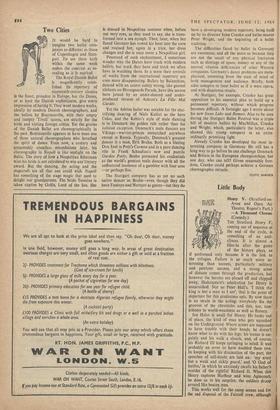Two Cities
IT would be hard to imagine two ballet com- panies so different as those of Copenhagen and Stutt- gart. To see them both within the same week makes the contrast as re- vealing as it is marked.
The Royal Danish Ballet is magnificently estab- lished. Its repertory of nineteenth-century classics is the finest, proudest in Europe, but the Danes, or at least the Danish sophisticates, give every impression of hating it. They want modern works, ideally by modern Danish choreographers, and the ballets by Bournonville, with their umpty and tumpty 'Tivoli' scores, arc strictly for the birds and visiting foreign critics. Yet the glories of the Danish Ballet are choreographically in the past. Bournonville appears to have been one of those natural choreographers who breathed the spirit of dance. Even now, a century and presumably countless emendations later, his choreography in Napoli is like sunlight on the Baltic. The story of how a Neapolitan fisherman wins his bride is not calculated to win any literary award. But the dancing, the acting and the stagecraft are all that one could wish. Napoli has something of the stage magic that used to delight our grandparents. The bride Teresina is taken captive by Golfo, Lord of the Sea. She
is dressed in Neapolitan costume when, before our very eyes, as they used to say, she is trans- formed into a sea nymph. Then, later, when her fiancé Gennaro has rowed his boat into the cave and rescued her, again in a trice, her dress changes and she is once more a Neapolitan girl.
Possessed of such enchantment, I sometimes wonder why the Danes have truck with modern ballets, but truck they have and truck we often have in watching them. In a sense their revivals of works from the international repertory are even more disappointing. Ballets by Balanchine, danced with an accent subtly wrong, like genteel sibilants on Horseguards Parade, have this season been joined by an under-danced and under- produced version of Ashton's La Fille Mal Gardee.
Yet the Ashton ballet was notable for the elec- trifying dancing of Niels Kehlet as the hero Colas, and the Kehlet's style of male dancing is in Denmark the golden rule rather than the isolated exception. Denmark's male dancers are Vikings—warrior-princes unmatched anywhere except in Russia. Typically, Denmark's greatest• dancer is a man, Erik Bruhn. Both as a blazing Don Jose in Petit's Carmen and in a pure dancing role in Frank Schaufuss's new and puerile Garden Party, Bruhn presented his credentials as the world's greatest male dancer with all the unflustered insolence of a gambler with four aces —or perhaps five.
The Stuttgart company has as yet no such native dancer as Bruhn—even though they did have Fonteyn and Nureyev as guests—but they do have a developing modern repertory, being built up by its director John Cranko and ballet-master Peter Wright, and the beginning of a ballet tradition.
The difficulties faced by ballet in Germany are enormous, and all the more so because they are not the result of any physical limitation such as shortage of space, money or any of the normal vitamin deficiencies of other Western companies. Germany's dance problems are meta- physical. stemming from the state of mind of both management and audience. Briefly, both sides conspire to treat ballet as if it were opera, and with disastrous results.
At Stuttgart, for example, Cranko has great opposition to his essential plan to build up a permanent repertory, without which progress becomes difficult. A fortnight ago I wrote about his new Swan Lake and Romeo. Also to be seen during the Stuttgart Ballet Festival was a triple bill of modern ballets by MacMillan, Cranko and Wright, which, particularly the latter, also showed this young company in an extra- ordinarily promising light.
Already Cranko has developed the most in- teresting company in Germany. He still has a long way to go before he can challenge Denmark and Britain in the European championships, but one day, who can tell? Given reasonable free- dom, Cranko could perhaps achieve a German choreographic miracle.
CLIVE BARNES


































 Previous page
Previous page